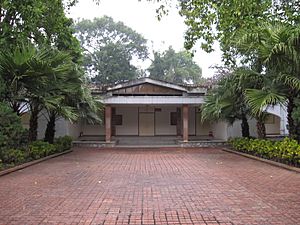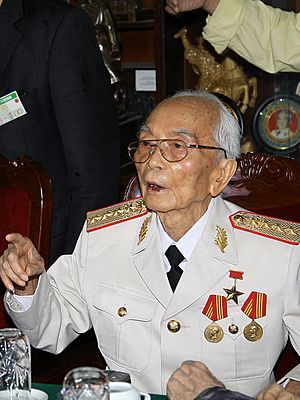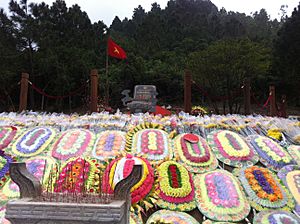Võ Nguyên Giáp facts for kids
Quick facts for kids
Võ Nguyên Giáp
|
|
|---|---|
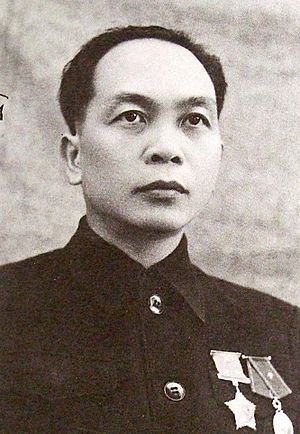
Giáp in 1957
|
|
| Deputy Prime Minister of Vietnam | |
| In office 20 September 1955 – 8 August 1991 |
|
| President | |
| Prime Minister | |
| Minister of Defence | |
| In office 1948–1980 |
|
| Prime Minister |
|
| Preceded by | Tạ Quang Bửu |
| Succeeded by | Văn Tiến Dũng |
| In office 11 May 1946 – 8 May 1947 |
|
| Prime Minister | Hồ Chí Minh |
| Preceded by | Phan Anh |
| Succeeded by | Tạ Quang Bửu |
| Personal details | |
| Born | 25 August 1911 Lệ Thủy, Quảng Bình, French Indochina |
| Died | 4 October 2013 (aged 102) Hanoi, Vietnam |
| Political party | CPV (1931–1992) |
| Spouses |
|
| Children | 5 |
| Alma mater | Indochinese University |
| Signature |  |
| Military service | |
| Allegiance | |
| Branch/service | |
| Years of service | 1944–1992 |
| Rank | Army general |
| Battles/wars |
|
| Awards |
|
Võ Nguyên Giáp (born August 25, 1911 – died October 4, 2013) was a famous Vietnamese general and politician. He was a key leader in Vietnam's fight for independence. Many people see him as one of the greatest military thinkers of the 20th century.
Giáp led Vietnamese forces in several wars. These included the fight against Japan in World War II. He also led the fight against France in the First Indochina War. Later, he commanded the army during the Vietnam War against South Vietnam and the United States. He also served as Vietnam's Minister of Defence and Deputy Prime Minister for many years.
Giáp was born in Quảng Bình province. His father was a Vietnamese nationalist. Giáp joined the Communist Party of Vietnam in 1931. This party was led by Ho Chi Minh. Giáp became well-known during World War II. He led the Việt Minh resistance against the Japanese. After the war, he became the military commander against the French.
Giáp won a huge victory at the Battle of Dien Bien Phu in 1954. This battle forced France to give up control of Vietnam. After Vietnam was divided, Giáp fought against South Vietnam and its American allies. He was the army commander during the 1968 Tet Offensive. He also led forces in the 1979 Sino-Vietnamese War. Giáp retired from his main roles in the 1980s. He passed away in 2013 at the age of 102.
Giáp is seen as a brilliant military builder. He turned a small group of rebels into a strong army. This army could challenge larger, more modern forces. He had no formal military training before World War II. He was a history teacher. He studied famous leaders like Napoleon and T. E. Lawrence. Some people called him "Red Napoleon." Giáp also planned the Ho Chi Minh trail. This trail brought supplies from North Vietnam to the South. It is considered a great feat of military engineering.
Contents
Biography
Early Life and Education
Võ Nguyên Giáp was born on August 25, 1911. He was born in Quảng Bình Province, which was then part of French Indochina. His parents, Võ Quang Nghiêm and Nguyễn Thị Kiên, were farmers. They lived a comfortable life.
Giáp's father was a Vietnamese nationalist. He was arrested by French authorities in 1919. He died in prison a few weeks later. Giáp had two sisters and one brother. One of his sisters was also arrested and died after her release.
Giáp was taught at home by his father. Later, he went to the village school. In 1924, at age thirteen, he went to the Quốc Học school in Huế. This school was run by the French. Other famous Vietnamese leaders also attended this school. These included Ngô Đình Diệm, who became President of South Vietnam. Ho Chi Minh also studied there years earlier.
At age 14, Giáp worked as a messenger. He was expelled from school for joining protests. He then joined the Tân Việt Revolutionary Party. This group taught him about communism. He was arrested in 1930 for student protests. He spent 13 months in Lao Bảo Prison. After his release, he joined the Communist Party of Vietnam in 1931.
From 1933 to 1938, Giáp studied at the Indochinese University in Hanoi. He earned a law degree. He focused on political economy.
Political Activities
While studying, Giáp lived with Professor Dang Thai Minh. He married the professor's daughter, Nguyen Thi Quang Thái, in 1938. She was also involved in revolutionary activities. They had a daughter named Hong Anh. Giáp's political work kept him busy. He failed his law exams. So, he became a history teacher at the Thăng Long School in Hanoi.
Giáp wrote articles for many revolutionary newspapers. He also studied military history and philosophy. He admired Sun Tzu and Napoleon. He also learned from T. E. Lawrence's book, Seven Pillars of Wisdom. This book taught him how to use military force effectively.
In 1940, the French government outlawed the Communist Party. Giáp left Vietnam for China. In China, he met Hồ Chí Minh. Giáp learned Chinese and studied Chinese Communist Party tactics.
In 1941, the Indochinese Communist Party formed the Viet Minh. Giáp was put in charge of setting up an intelligence network. He also organized political bases in northern Vietnam. He wrote many articles for their newspaper, Việt Nam Độc Lập.
Military Career
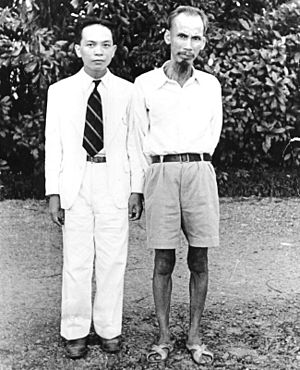
In 1942, Giáp and about forty men moved back into Vietnam. They set up in caves near Vu Nhai. These small groups formed the basis of the Viet Minh. This was the armed part of the Vietnam Independence League. Giáp worked to build a small military force. He also tried to win over local people to the communist cause. By late 1943, hundreds had joined the Viet Minh. Giáp learned that his wife and daughter had died in prison.
In September 1944, the first Revolutionary Party Military Conference was held. They decided to move forward with military struggle. The Vietnam Liberation army was formed. Giáp became its commander. Ho Chi Minh told him to create Armed Propaganda Brigades. The first one was formed in December 1944. It had thirty-one men and three women. It was named the Tran Hung Dao Platoon.
Ho Chi Minh wanted the unit to win a victory quickly. So, on December 25, 1944, Giáp led attacks on French outposts. These were the Battles of Khai Phat and Na Ngan. The Viet Minh won without any losses. A few weeks later, Giáp was wounded in another attack.
Through 1945, Giáp's military strength grew. The French and Japanese power weakened. In March, the Japanese took over from the French. They put Emperor Bảo Đại in charge of a puppet state.
By April, the Viet Minh had almost five thousand members. They could attack Japanese posts confidently. From May to August 1945, the United States helped train and supply Giáp and the Viet Minh. They taught them how to use modern weapons. Giáp's forces took more territory. On August 15, Japan surrendered to the allies.
On August 28, 1945, Giáp led his men into Hanoi. On September 2, Ho Chi Minh declared Vietnam's independence. He formed a new government. Giáp became Minister of the Interior. However, other world leaders had already decided Vietnam's future. They agreed that the north would be controlled by China. The south would be controlled by Britain.
Chinese forces took control of the north in September. British forces arrived in Saigon in the south. By October, French forces began to arrive. The British gave control of the south back to them. In May 1946, the Chinese left the north. The French moved in there too. Ho Chi Minh and Võ Nguyên Giáp tried to negotiate with the French. They wanted to avoid a full war. Giáp led the Vietnamese team at the Dalat conference in April 1946. It did not achieve peace. Giáp was then made Minister of Defense.
While Ho Chi Minh was in France, Giáp was in charge in Hanoi. He closed down newspapers that attacked him. He also used Viet Minh forces against non-communist groups. He had their leaders arrested or killed.
First Indochina War
The situation between Vietnam and the French became very tense. On October 23, the French ordered a ship to bomb Haiphong. This was in response to fights with Vietnamese forces. About six thousand people were killed. Giáp tried to keep peace. But by the time Ho Chi Minh returned, both sides were ready for war.
On December 19, the Vietnamese government declared war on France. Fighting broke out across the country. The first few years were a low-level resistance fight. Giáp saw his first real fighting in Nha Trang in 1946. After 1949, the conflict became a full war. Both sides had modern weapons. The United States supplied France. The Soviet Union supplied Vietnam.
French Union forces included troops from many parts of the French empire. These included soldiers from Morocco, Algeria, and Vietnam. French professional troops and the French Foreign Legion also fought. French governments did not allow recruits from France itself to fight. This was to keep the war from becoming unpopular at home.
The French government tried to make a deal with the Viet Minh. They offered to help set up a national government. They also promised Vietnam independence later. But Ho Chi Minh and the Viet Minh leaders did not trust the French. They continued the war.
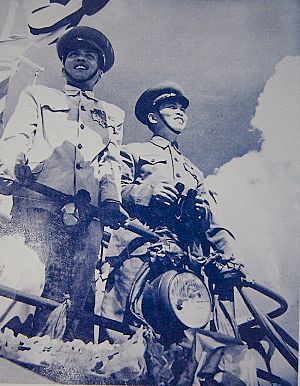
French public opinion turned against the war. Many French troops had been killed or captured. The war was very expensive. It had lasted seven years with no clear victory. Many French people felt their country had no moral reason to be in Vietnam. Some French people supported the Viet Minh's goal of a socialist state.
The Viet Minh grew stronger in Vietnam. They also expanded the war into other areas like Laos. In December 1953, French General Henri Navarre set up a base at Ðiện Biên Phủ. He thought Giáp would attack it directly. Navarre believed he would have the advantage in a big battle.
Giáp accepted the challenge. While the French dug in, the Viet Minh prepared. Giáp ordered his men to move their artillery by hand. They placed twenty-four large guns on the hills around Dien Bien Phu. They dug deep holes to protect them from French planes.
With anti-aircraft guns from the Soviet Union, Giáp limited French supplies. French planes had to drop supplies from high up. Giáp also ordered his men to dig a system of trenches. These trenches surrounded the French base. The Viet Minh could move close to the French troops.
When Navarre realized he was trapped, he asked for help. The United States thought about using nuclear weapons. But this idea was not seriously considered. Another idea was to use air raids. But U.S. President Dwight D. Eisenhower refused to act alone. British Prime Minister Winston Churchill also refused to get involved. He wanted to wait for peace talks in Geneva.
On March 13, 1954, Giáp launched his attack. For 54 days, the Viet Minh took position after position. They pushed the French back. The French surrendered on May 7. Over 2,200 French soldiers were killed. More than 11,700 were taken prisoner. The next day, the French government announced it would leave Vietnam.
Giáp's victory at Dien Bien Phu inspired many anti-colonial movements. It was especially important in French colonies in North Africa. This victory marked a new era in the fight for national freedom.
Interwar Years
After the French surrender, Giáp returned to Hanoi. The Vietnamese government was re-established. He expanded and modernized the army. They used Russian and Chinese weapons. He started the Vietnamese Maritime Force in 1955. He also started the Vietnamese People's Air Force in 1959.
In the late 1950s, Giáp was Minister of Defence. He was also Commander in Chief of the People's Army of Vietnam. He was Deputy Prime Minister too. In his personal life, he reunited with his wife. They had been separated for eight years during the war. They raised two boys and two girls. In his free time, he enjoyed playing piano and reading books.
The Vietnamese government focused on building a socialist economy. This meant taking over farms and managing all production. This process was difficult. It led to food shortages and revolts.
The French left, and Vietnam was divided. The Hanoi government controlled only the north. In South Vietnam, thousands of fighters, called Viet Cong, fought against the government. Giáp was put in charge of building their strength. In 1959, it was decided to increase the armed struggle in the South. Giáp ordered the opening of the Ho Chi Minh trail. This improved supply lines to Viet Cong units.
Vietnam War
Giáp remained commander in chief of the People's Army of Vietnam. He led the army throughout the war against South Vietnam. Their allies included the United States, Australia, and South Korea. He oversaw the army's growth. It became a large, modern force. It was equipped with advanced weapons from communist allies.
Many people thought Giáp planned the 1968 Tet Offensive. But it seems he did not like the plan. He left Vietnam for medical treatment in Hungary. He returned after the offensive began. The offensive failed to cause a general uprising. However, it was a big political victory. It convinced American politicians that the war could not last forever. Giáp later said the Tet Offensive was not just a military plan. It was part of a larger strategy.
Peace talks began in Paris in January 1969. Representatives from the United States, South Vietnam, North Vietnam, and the Viet Cong attended. President Richard Nixon wanted to withdraw U.S. troops. It took four years for the last American troops to leave.
In October 1972, negotiators almost agreed to end the conflict. U.S. troops would leave South Vietnam. There would be a cease-fire. American prisoners would be returned. Both North and South Vietnamese governments would stay in power. Reunification would happen peacefully, step by step.
President Nixon ordered air raids on Hanoi and Haiphong. This was called Operation Linebacker II. It aimed to pressure both sides. The operation ended on December 29, 1972. North Vietnam then agreed to sign the Paris Peace Accords. South Vietnam had to accept it.
The last U.S. combat troops left in August 1972. Other U.S. military staff left in March 1973. But the fighting did not stop. Communist leaders met in Hanoi in March 1973. They planned a big attack on the South. In June 1973, the U.S. Congress stopped further U.S. military involvement. This meant the PAVN supply routes could operate without U.S. bombing.
Fall of Saigon
After Ho Chi Minh's death in 1969, some say Giáp lost power. He was blamed for the failed Easter Offensive in 1972. He was replaced as field commander. The glory for the 1975 victory went to General Văn Tiến Dũng. Giáp's role in the 1975 victory is often not fully recognized in official Vietnamese accounts.
Later Life
After the fall of Saigon, the Socialist Republic of Vietnam was formed. Giáp became Deputy Prime Minister in July 1976. In December 1978, he led the successful Cambodian–Vietnamese War. This war removed the Khmer Rouge from power. In return, China invaded Vietnam in January 1979. Giáp was in charge of the response. His forces pushed the Chinese back.
He retired from the Defense Ministry in 1981. He left the Politburo in 1982. He remained Deputy Prime Minister until 1991.
Giáp wrote many books on military ideas and strategy. His works include Big Victory, Great Task and People's Army, People's War.
In 1995, former U.S. Secretary of Defense Robert McNamara met Giáp. He asked about the second Gulf of Tonkin Incident in 1964. Giáp replied, "Absolutely nothing." He claimed the attack was imagined.
American historian Derek Frisby said Giáp understood "revolutionary war." He explained that Giáp knew war would cost many lives. But as long as the army survived, the idea of Vietnam would live on. This was the core of his strategy.
In 2009, Giáp spoke out against bauxite mining in Vietnam. He said a 1980s study warned against it. He believed it would cause severe environmental damage.
Death and Legacy
On October 4, 2013, Võ Nguyên Giáp passed away. He was 102 years old. He died at a military hospital in Hanoi. He was given a state funeral on October 12–13. His body was buried in his home province of Quảng Bình. After his death, several cities in Vietnam renamed streets after him.
Awards and Decorations
See also
 In Spanish: Võ Nguyên Giáp para niños
In Spanish: Võ Nguyên Giáp para niños


